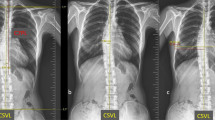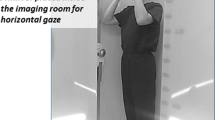Abstract
Purpose
Aging and spinal disease impair standing whole body sagittal alignment (WBS alignment), which leads to stooping. When WBS alignment deteriorates, compensatory mechanisms are activated to maintain standing posture. Increase of the compensation impairs health-related quality of life (HRQOL). The purpose of this research was to determine whether postural factors, age, and sex affect HRQOL.
Methods
This cross-sectional study evaluated the influence of WBS alignment, standing body sway (balance), skeletal muscle mass (SMM), aging, and sex on HRQOL in healthy volunteers (n = 150; mean age 40.9 years [20–76], 96 women). Age, sex, weight, height, and body mass index (BMI) were obtained. HRQOL was assessed with Scoliosis Research Society-22 (SRS-22r). WBS alignment and balance were measured by EOS imaging with simultaneous force plate measurement. SMM was measured using a medical body composition analyzer. Based on the bivariate analysis between the SRS-22r subtotal and all parameters, selected ten parameters were used for multivariate logistic regression analysis to identify affecting factors to SRS-22r.
Results
Men had significantly higher weight, height, BMI, and SRS-22r score in all domains. The L4-S1 lumbar lordosis angle was greater in men, and pelvic tilt and knee hyperextension were greater in women. Women had a more stable standing posture, whereas men had significantly higher SMM values. Multivariate logistic regression analysis revealed that age, sex, and TPA were identified as significant factors affecting SRS-22r.
Conclusions
In healthy volunteers, SRS-22r is affected by aging, sex (woman had a lower score), and sagittal malalignment. Neither Standing balance nor SMM, however, affect SRS-22r.4






Similar content being viewed by others
References
Amabile C, Le Huec JC, Skalli W (2018) Invariance of head-pelvis alignment and compensatory mechanisms for asymptomatic adults older than 49 years. Eur Spine J 27(2):458–466
Bao H, Lafage R, Liabaud B, Elysée J, iebo BG,Poorman G,Jalai C, Passias P,Buckland A, Bess S,Errico T, Lenke LG, Gupta M, Kim HJ, Schwab F, Lafage V (2018) Three types of sagittal alignment regarding compensation in asymptomatic adults: the contribution of the spine and lower limbs. Eur Spine J 27(2):397-405
Duval-Beaupère G, Legaye J (2004) Composante sagittale de la statique rachidienne. Rev Rhum 71:105–119
Hasegawa K, Okamoto M, Hatsushikano S, Shimoda H, Ono M, Homma T, Watanabe K (2017) Standing sagittal alignment of the whole axial skeleton with reference to the gravity line in humans. J Anat 230(5):619–630
Dubousset J (1994) Three-dimensional analysis of the scoliotic deformity. In: Weinstein SL (ed) Pediatric Spine: principles and practice. Raven Press, New York, pp 479–483
Hasegawa K, Dubousset J (2022) Cone of economy with chain of balance–Historical perspective and the evidence of the concept. Spine Surg Rel Res 6(4):337–349. https://doi.org/10.22603/ssrr.2022-0038
Haddas R, Lieberman IH (2019) The change in sway and neuromuscular activity in adult degenerative scoliosis patients pre and post surgery compared with controls. Spine 44(15):E899–E907
Glassman SD, Bridwell K, Dimar JR, Horton W, Berven S, Schwab F (2005) The impact of positive sagittal balance in adult spinal deformity. Spine 30(18):2024–2029
Schwab FJ, Blondel B, Bess S, Hostin R, Shaffrey CI, Smith JS, Boachie-Adjei O, Burton DC, Akbarnia BA, Mundis GM, Ames CP, Kebaish K, Hart RA, Farcy JP, Lafage V (2013) Radiographical spinopelvic parameters and disability in the setting of adult spinal deformity: a prospective multicenter analysis. Spine 38(13):E803–E812
Itoi E (1991) Roentgenographic analysis of posture in spinal osteoporotics. Spine 16(7):750–756
Le Huec JC, Charosky S, Barrey C, Rigal J, Aunoble S (2011) Sagittal imbalance cascade for simple degenerative spine and consequences: algorithm of decision for appropriate treatment. Eur Spine J 20(Suppl 5):699–703
Hasegawa K, Okamoto M, Hatsushikano S, Watanabe K, Ohashi M, Vital JM, Dubousset J (2020) Compensation for standing posture by whole-body sagittal alignment in relation to health-related quality of life. Bone Joint J 102-b(10): 1359–67
Choy NL, Brauer S, Nitz J (2003) Changes in postural stability in women aged 20 to 80 years. J Gerontol A Biol Sci Med Sci 58(6):525–530
Era P, Sainio P, Koskinen S, Haavisto P, Vaara M, Aromaa A (2006) Postural balance in a random sample of 7979 subjects aged 30 years and over. Gerontology 52(4):204–213
Maki BE, Holliday PJ, Fernie GR (1990) Aging and postural control. A comparison of spontaneous- and induced-sway balance tests. J Am Geriatr Soc 38(1):1–9
Imaoka K, Murase H (1997) Fukuhara M (1997) Collection of data for healthy subjects in stabilometry. Equilib Res 56:1–84
Fairbank JCT, Pynsent PB (2000) The oswestry disability index. Spine 25:2940–2953
Hori Y, Hoshino M, Inage K, Miyagi M, Takahashi S, Ohyama S, Suzuki A, Tsujio M, Terai H, Dohzono S, Sasaoka R, Toyoda H, Kato M, Matsumura A, Namikawa T, Seki M, Yamada Y, Habibi H, Salimi H, Yamashita M, Yamauchi T, Furuya T, Orita S, Maki S, Shiga Y, Inoue M, Inoue G, Fujimaki H, Murata K, Kawakubo A, Kabata D, Shintani A, Ohtori S, Takaso M, Nakamura H (2019) Clinical importance of trunk muscle mass for low back pain, spinal balance, and quality of life-a multicenter cross-sectional study. Eur Spine J 28(5):914–921
Merrill RK, Kim JS, Leven DM, Kim JH, Meaike JJ, Bronheim RS, Suchman KI, Nowacki D, Gidumal S, Cho SK (2018) Differences in fundamental sagittal pelvic parameters based on age, sex, and race. Clin Spine Surg 31(2):E109–E114
Yukawa Y, Kato F, Suda K, Yamagata M, Ueta T, Yoshida M (2018) Normative data for parameters of sagittal spinal alignment in healthy subjects: an analysis of gender specific differences and changes with aging in 626 asymptomatic individuals. Eur Spine J 27(2):426–432
LaPier TLK, Liddle S, Bain C (1997) A comparison of static and dynamic standing balance in older men versus women. Physiother Can 49:207–213
Asher M, Min Lai S, Burton D, Manna B (2003) The reliability and concurrent validity of the Scoliosis Research Society-22 patient questionnaire for idiopathic scoliosis. Spine 28(1):63–69
Hashimoto H, Sase T, Arai Y, Maruyama T, Isobe K, Shouno Y (2007) Validation of a Japanese version of the scoliosis research society-22 patient questionnaire among idiopathic scoliosis patients in Japan. Spine 32:E141–E146
Dubousset J, Charpak G, Dorion I, Skalli W, Lavaste F, Deguise J, Kalifa G, Ferey S. Le système EOS (2005) Nouvelle imagerie Ostéo-Articulaire basse dose en position debout. e-Mémoires de l'Académie Nationale de Chirurgie 4(4): 22–7
Hasegawa K, Okamoto M, Hatsushikano S, Shimoda H, Ono M, Watanabe K (2016) Normative values of spino-pelvic sagittal alignment, balance, age, and health-related quality of life in a cohort of healthy adult subjects. Eur Spine J 25(11):3675–3686
Okamoto M, Jabour F, Sakai K, Hatsushikano S, Le Huec JC, Hasegawa K (2018) Sagittal balance measures are more reproducible when measured in 3D vs in 2D using full-body EOS® images. Eur Radiol 28(11):4570–4577
Protopsaltis T, Schwab F, Bronsard N, Bronsard N, Smith JS, Klineberg E, Mundis G, Ryan DJ, Hostin R, Hart R, Burton D, Ames C, Shaffrey C, Bess S, Errico T, Lafage V, International Spine Study Group (2014) The T1 pelvic angle, a novel radiographic measure of global sagittal deformity, accounts for both spinal inclination and pelvic tilt and correlates with health-related quality of life. J Bone Joint Surg Am 96(19):1631–1640
Bryant EC, Trew ME, Bruce AM, Kuisma RME, Smith AW (2005) Gender differences in balance performance at the time of retirement. Clin Biomech (Bristol, Avon) 20(3):330–335
Kim JW, Kwon Y, Ho Y, Jeon HM, Bang MJ, Jun JH, Eom GM, Park BK, Cho YB (2014) Age-gender differences in the postural sway during squat and stand-up movement. Biomed Mater Eng 24(6):2707–2713
Bosy-Westphal A, Jensen B, Braun W, Pourhassan M, Gallagher D, Müller MJ (2017) Quantification of whole-body and segmental skeletal muscle mass using phase-sensitive 8-electrode medical bioelectrical impedance devices. Eur J Clin Nutr 71(9):1061–1067
Ko H, Park YH, Cho B, Lim KC, Chang SJ, Yi YM, Noh EY, Ryu SI (2019) Gender differences in health status, quality of life, and community service needs of older adults living alone. Arch Gerontol Geriatr 83:239–245
Fischer B, Mitterocker P (2017) Allometry and sexual dimorphism in the human pelvis. Anat Rec 300(4):698–705. https://doi.org/10.1002/ar.23549
Carmona M, Tzioupis C, LiArno S, Faizan A, Argenson JN, Ollivier M (2019) Upper femur anatomy depends on age and gender: a three-dimensional computed tomography comparative bone morphometric analysis of 628 healthy patients’ hips. J Arthroplasty 34(10):2487–2493. https://doi.org/10.1016/j.arth.2019.05.036 (Epub 2019 May 29)
Bosy-Westphal A, Schautz B, Later W, Gallagher D, Müller MJ (2013) What makes a BIA equation unique? Validity of eight-electrode multifrequency BIA to estimate body composition in a healthy adult population. Eur J Clin Nutr 67(Suppl 1):S14–S21
González-Correa CH, Caicedo-Eraso JC (2012) Bioelectrical impedance analysis (BIA): a proposal for standardization of the classical method in adults. J Phys Conf Ser 407:012018
Hori Y, Hoshino M, Inage K, Miyagi M, Takahashi S, Ohyama S, Suzuki A, Tsujio M, Terai H, Dohzono S, Sasaoka R, Toyoda H, Kato M, Matsumura A, Namikawa T, Seki M, Yamada Y, Habibi H, Salimi H, Yamashita M, Yamauchi T, Furuya T, Orita S, Maki S, Shiga Y, Inoue M, Inoue G, Fujimaki H, Murata K, Kawakubo A, Kabata D, Shintani A, Ohtori S, Takaso M, Nakamura H (2021) Gender-specific analysis for the association between trunk muscle mass and spinal pathologies. Sci Rep 11(1):7816
Yonei Y, Miwa Y, Hibino S, Takahashi Y, Miyazaki R, Yoshikawa T, Moriwaki H, Hasegawa T, Hiraishi T, Torii K (2008) Japanese anthropometric reference data – special emphasis on bioelectrical impedance analysis of muscle mass. Anti-Aging Medicine 5:63–72
Hasegawa K, Hatsushikano S, Le Huec JC, Sardar Z, Wong HK, Dennis Hey HW, Liu G, Bourret S, Kelly M, Riahi H, Chelli-Bouaziz M, Lenke LG (2022) Pelvic thickness, sex, ethnicity, and age affect pelvic incidence in healthy volunteers of Multi-Ethnic Alignment Normative Study (MEANS) database. Eur Spine J 31(6):1421–1430. https://doi.org/10.1007/s00586-022-07134-w
Acknowledgements
The authors deeply thank Masashi Okamoto, MS, Dept. of Radiological Technology, School of Health Science, Faculty of Medicine, Niigata University, for his contribution to the data collection and adjustment, and Satoshi Aoki, Representative Director, seca Nihon, for his advice on bioelectrical impedance analysis of skeletal muscle mass.
Funding
No funding has received for the present study and the scientific paper.
Author information
Authors and Affiliations
Contributions
K. H contributed to study design, data collection, manuscript writing, and statistical analysis, S. H contributed to data collection and radiologic measurement, K. W contributed to manuscript editing, M. O contributed to manuscript editing, J. D contributed to conceptual advice for study design and manuscript editing.
Corresponding author
Ethics declarations
Conflict of interest
None of the authors received financial support or COI for the present study.
Ethics approval
The ethics committee of Medical Corporation Aijinkai approved the study with the committee’s reference number: IRB Approval #6 [R1] – 2019, on May 16, 2019.
Consent to participate
A written informed consent to participate in the present study was obtained from all the participants.
Consent for publication
A written informed consent for publication was obtained from all the participants.
Additional information
Publisher's Note
Springer Nature remains neutral with regard to jurisdictional claims in published maps and institutional affiliations.
Rights and permissions
Springer Nature or its licensor holds exclusive rights to this article under a publishing agreement with the author(s) or other rightsholder(s); author self-archiving of the accepted manuscript version of this article is solely governed by the terms of such publishing agreement and applicable law.
About this article
Cite this article
Hasegawa, K., Hatsushikano, S., Watanabe, K. et al. Scoliosis Research Society-22r score is affected by standing whole body sagittal alignment, age, and sex, but not by standing balance or skeletal muscle mass in healthy volunteers. Eur Spine J 31, 3000–3012 (2022). https://doi.org/10.1007/s00586-022-07360-2
Received:
Revised:
Accepted:
Published:
Issue Date:
DOI: https://doi.org/10.1007/s00586-022-07360-2




